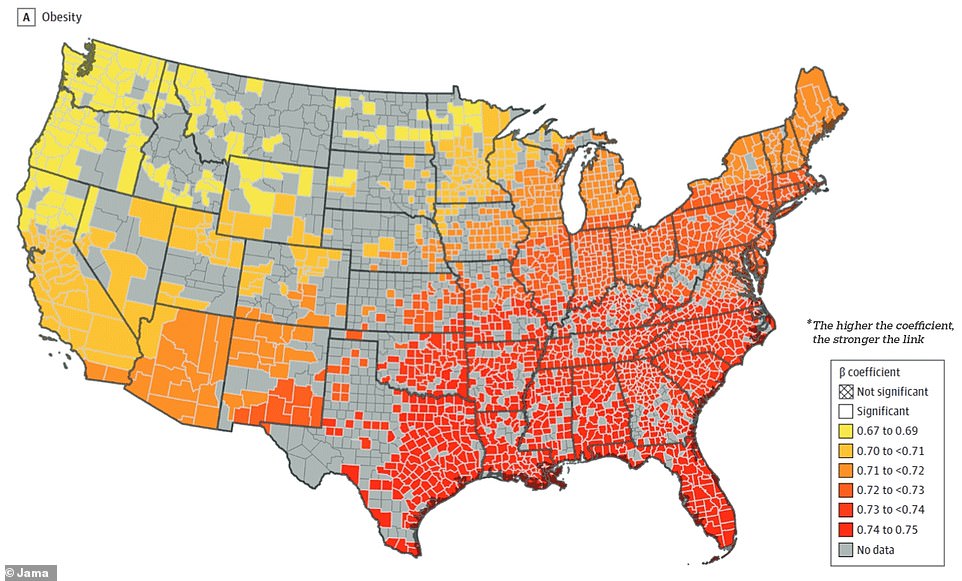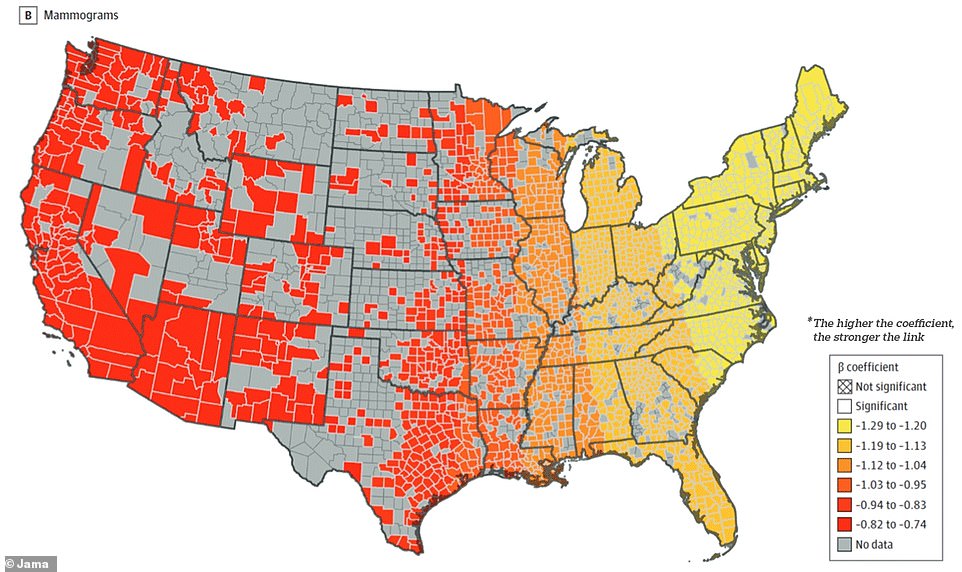America’s breast cancer zip code lottery: Death rates among women vary by up to six-fold between counties in the SAME state
Women are six times more likely to die from bEast cancer in different counties within the same state as a result of a zip code lottery, according to a unique study of its kind.
The country-to-country differences reflect the varying degrees of influence that major risk factors have on breast cancer death, including obesity and a history of smoking.
Researchers in Virginia used federal data to look at breast cancer deaths in more than 2,000 counties to map differences in death rates.
Death rates can vary drastically from county to neighbor, such as Lamar County, Alabama, where a total of about one in 33 women die from breast cancer, compared to nearby Cullman, where that figure rises to one in nine.
The researchers said: ‘These results suggest that breast cancer mortality in the US may be influenced by where individuals live, and that more comprehensive and geographically targeted interventions could lead to healthier communities.’
The gray provinces contain no data. Those that did have relevant data are colored in shades of purple. The researchers’ work showed not only which states have higher breast cancer death rates, but also individual counties. Alabama, for example, is an example of significant county-by-county variation. The northern part of the state showed more variation in death rates than the southern region

Breast cancer is the leading cause of cancer-related deaths among women in the US, but the death rate has fallen 43 percent between 1989 and 2020
The authors added, “Alabama is a clear example of the disparate outcomes breast cancer patients experience based on their geographic location, even under uniform state programs.
“While the northern part of the state showed significant differences in age-adjusted death rates between counties, the southern part of the state showed more homogeneous rates.”
Alabama wasn’t the only state with a collection of counties with vastly different death rates. For example, the death rate ranged between nine and seventeen per 100,000 women in Person County, North Carolina. But in Caswell County, right next door, that rate was between 25 and 33 per 100,000 women.
In Garfield County, Utah, between one in 33 and one in 57 die from breast cancer, compared to one in nine to 17 in neighboring Iron County.
In Putnam County, Ohio, between one in 25 and one in 33 die from breast cancer, compared to neighboring Paulding County, where an estimated one in 17 to 21 die from the same cause.
And in Okanogan County, the death rate runs between 33 and 57 deaths per 100,000 people, compared with nine to 17 per 100,000 in Douglas County immediately to the south.
Different variables contributing to fatal cases of breast cancer had different levels of impact.

Obesity was influential in 100 percent of counties, but those in the southeastern U.S. had marginally higher coefficients, meaning obesity rates had a slightly greater impact in those counties

Counties in red have a lower coefficient range than counties shaded in yellow, meaning that while access to preventive breast X-rays was universally influential, the relationship between access to mammograms and breast cancer deaths was strongest in eastern states.

In the South and East, where counties are colored yellow and orange, the association between access to nutritious food and breast cancer mortality rates is represented by a coefficient range of −1.55 to −2.85, while in the West the coefficient fell between -1.07. to -0.36. However, the map shows areas in Ohio, Pennsylvania, Tennessee and Kentucky where the relationship between the two is stronger than in the region as a whole
They found that obesity rates in certain areas, particularly in a long string of counties in the Bible Belt states, had a stronger link with breast cancer deaths than those in the Pacific Northwest. In eastern states, access to mammograms affected mortality.
Obesity contributed to deaths in every county the researchers looked at, but cigarette smoking was estimated to have played a role in increasing death rates in less than 17 percent of counties.
And whether people in a county had access to nutritious, healthy food affected death rates in more than 80 percent of counties.
Access to health care services, including preventive measures such as mammograms, had a universal impact on breast cancer deaths. As more women underwent X-rays to detect cancer, fewer died.
And while breast cancer is the most common type among women, with more than 264,000 cases diagnosed annually in the U.S., mammograms and other screening tools, as well as innovations in cancer treatments, have helped reduce the death rate.
Deaths from breast cancer fell by 43 percent between 1989 and 2020 after successful public health awareness campaigns, better screening and new medications.
To help researchers dig deep into the county-level data, the researchers relied on two statistical analysis methods: Ordinary Least Squares (OLS) and Multiscale Geographically Weighted Regression (MGWR).
The relationship between breast cancer deaths and several variables that influence them, including access to healthy diets and mammograms, is shown using a coefficient, or a number that represents the strength of a relationship between two variables.
A higher coefficient number indicates a stronger relationship.
Both models showed that the effects of mammogram intake and obesity had a uniform impact, allowing the researchers to see that these relationships were strongest in most counties from North Carolina and Florida to eastern Oklahoma and Texas.
They also found that access to mammograms had an even stronger impact on keeping breast cancer death rates low in most East Coast counties, stretching from Maine to North Carolina.
The food environment was influential in most counties, but even more so in the counties of the southern and eastern states compared to the western US.
Obesity had an even greater impact on the counties of the Southern states than on the West.
The findings were published in the journal JAMA network opened.
